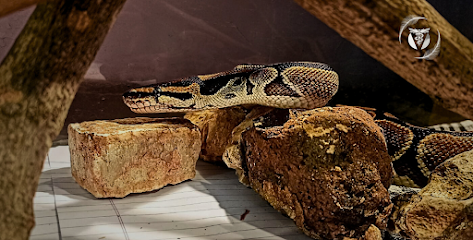The Herp Index: Why Is My Snake Refusing To Eat?
 |
Few things worry snake keepers more than a pet
that suddenly stops eating. This causes owners to panic - Why is my snake not
eating? Is it
stressed? Sick? Or just being a picky serpent?
As a snake owner, I get this question all the
time, and the truth is: snakes refusing food can be perfectly normal—or a red
flag that needs attention. The trick is knowing the difference.
In this post, we’ll walk through the common
reasons snakes go off food, how to separate harmless fasting from health
issues, and the practical steps you can take to get them feeding again.
Why is My Snake Not Eating? Common Reasons
Not all feeding refusals are alarming. Here are the most common causes:
 |
| ~ Classic visible signs that Google is about to shed ~ |
- Shedding:
Appetite often dips a week before shedding. Dull skin and cloudy eyes
(“blue eyes”) are tell-tale signs.
- Seasonal
cycles: Some snakes naturally slow their feeding
in cooler months or during brumation.
- Stress: New
environment, too much handling, loud noises, or lack of hides can make a
snake feel unsafe enough to skip meals.
- Wrong
environment: Incorrect temperature or humidity is one
of the biggest appetite killers.
- Meal
problems: Prey too large, too cold, or not the
species your snake prefers.
- Health
concerns: Mouth rot, respiratory infections,
parasites, or digestive blockages can all show up as loss of appetite.
- Reproductive
changes: Gravid females may stop eating for a
while.
When to Worry About a Snake Refusing Food
Refusal during shedding or short seasonal
fasts is usually fine. But it’s time to call your vet if you notice:
- Weight
loss along with fasting
- No
food intake for several weeks in young snakes or months in adults
- Wheezing,
nasal discharge, mouth lesions
- Stuck
shed around eyes or body
- Lethargy
or sudden change in behavior
Here's What You Can Do When Your Snake Won't Eat
1. Check the Basics
- Confirm
your enclosure has the right temperature gradient (warm basking
spot + cooler end).
- Monitor
humidity for the species.
- Provide
secure hides—a nervous snake often won’t eat.
 |
| ~ Google in his hideout - an inverted clay pot ~ P.S: look at that crazy iridescent shine on my boy <3 |
Vet Tip: A thermometer on the tank wall isn’t enough—use a digital probe at both the warm and cool ends.
2. Fix the
Feeding Setup
- If possible, provide live prey. Hunting serves as enrichment as well.
- Warm
thawed prey to approximate body temperature.
- Try
different presentation: tongs, leaving prey overnight, or a slight wiggle
to mimic live movement.
- “Scent”
the prey with bedding or fluids from another prey type if your snake is
being picky.
3. Reduce Stress
- Avoid
handling for several days before and after feeding.
- Place
the enclosure in a quiet, low-traffic spot.
- Stick
to consistent day/night cycles.
4. Time It
Right
- Many
snakes are crepuscular or nocturnal—try feeding at dusk or after lights go
off.
- Don’t
offer food too soon after a large meal—give digestion time.
5. Monitor
Closely
- Weigh
your snake weekly to track subtle changes.
- Keep a
simple log of feeding attempts, success/failure, and environment.
- If
appetite doesn’t return in a reasonable time for that species—or you spot
illness—book a vet visit.
Real-World Scenarios
- Corn
snake in shed: Refuses food for 10 days, sheds cleanly,
resumes eating the next week. Normal.
- Ball
python after relocation: Stops eating, loses weight, found to
have low enclosure temps. After heating fixed and hides added, appetite
returned. Corrected husbandry.
- Boa
with mouth lesions: Refuses food, drooling noted. Vet
diagnosed stomatitis; antibiotics resolved issue. Medical case.
Closing Thoughts
A fasting snake isn’t always a sick snake.
Sometimes, it’s just nature at work. But as a keeper, your role is to stay
observant: check the environment, watch the body condition, and act if red
flags appear.
Patience, proper husbandry, and timely veterinary care go a long way in turning a stubborn feeder back into a healthy, hungry snake.
That's all, folks.
I will be posting more articles covering rehabilitation, enclosures, diet, free flight, and training with various species, including turtles, snakes, dogs, and more.
- Gmail - namratansahoo@gmail.com
- Instagram - @TheVetDiariesBlog
- Subscribe to my YouTube: The Vet Diaries




.jpg)





Comments
Post a Comment